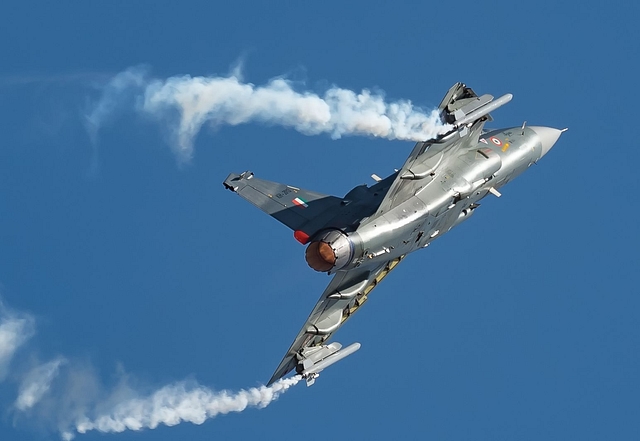Defence
Here Are Six Major Improvements LCA Tejas Mark-1A Will Have Over Mark-1 Variant Of The Fighter

Tejas fighter (Venkat Mangudi/Wikipedia)
Earlier today, the Cabinet Committee on Security, headed by Prime Minister Narendra Modi, approved the procurement of 83 Mark-1A Tejas fighters for the Indian Air Force at a cost of Rs 48,000 crore. A deal is likely to be signed with Hindustan Aeronautics Limited in February this year during the AeroIndia show in Bengaluru.
Tejas Mark-1A, the new variant of the Light Combat Aircraft, will have multiple improvements over the Mark-1 variant of the fighter to enhance its performance and improve its maintainability. Here are the six major improvements that the new variant of the indigenously-developed fighter will have:
1) AESA radar
The new Tejas variant will come equipped with an Active Electronically Scanned Array (AESA) radar. Given that the UTTAM AESA radar being developed by the Defence Research and Development Organisation is not ready, the Mark-1A variant of the Tejas fighter will be equipped with an Israeli Elta AESA radar.
An AESA radar has a longer range and better resistance to jamming than the current manually scanned Israeli Elta EL/M 2032 radar on Tejas Mark-1.
However, the selection of an Israeli radar may have one major disadvantage. Equipping the Tejas Mark-1A with an Israeli radar will rule out the possibility of the fighter getting Meteor long-range air-to-air missiles which the IAF has purchased for its Rafales. This is because the maker of the Meteor missile, MBDA, has said that it would only fit the missile onto a fighter with a European airborne radar.
2) Mid-air refuelling
The Mark-1A variant will roll off the production line with mid-air refueling capability, which will help increase the range of the single-engine fighter significantly. Air-to-Air refuelling capability will be a force multiplier for the IAF as it will give the Tejas the potential to stay airborne for much longer periods of time.
3) Easier to maintain
Tejas Mark-1A will have nearly 40 improvements over the previous variant to improve its maintainability. This includes the reduction of screws in several airframe panels that required daily servicing to reduce the turn around time of the aircraft.
The Mark-1A variant will also come with ground handling aids and testers to enable speedier turnaround of aircraft by maintenance teams.
4) Upgraded Radar Warning Receiver
Equipped with a significantly upgraded Radar Warning Receiver (RWR) system, the Mark-1A variant of the fighter will be better prepared to detect and defeat ground-based and airborne threats. A radar warning receiver detects when an enemy aircraft’s radar picks up one’s own aircraft and alerts the pilot.
5) External Self Protection Jammer pod
Tejas Mark-1A will also be equipped with an external Self Protection Jammer (SPJ) pod. The SPJ will enhance the survivability of the fighter against air-to-air and surface-to-air threats in a dense radar-guided weapons system environment.
6) Beyond Visual Range missile
The Tejas fighter has already fired Derby-I, an Israeli beyond visual range air-to-air (BVRAAM) with a range of around 50 kilometers. Apart from this, the Indian Air Force plans to integrate the indigenous Astra BVRAAM on the platform. Astra missile will soon be tested from the fighter, reports said in November 2020.
While the Tejas has already proved its capability to fire missiles like Vympel R-73 Close Combat Missiles and a Derby BVR missile, experts say the fighter will have to be tested with R-77, Python-5 and DRDO Astra in the near future.
Introducing ElectionsHQ + 50 Ground Reports Project
The 2024 elections might seem easy to guess, but there are some important questions that shouldn't be missed.
Do freebies still sway voters? Do people prioritise infrastructure when voting? How will Punjab vote?
The answers to these questions provide great insights into where we, as a country, are headed in the years to come.
Swarajya is starting a project with an aim to do 50 solid ground stories and a smart commentary service on WhatsApp, a one-of-a-kind. We'd love your support during this election season.
Click below to contribute.
Latest